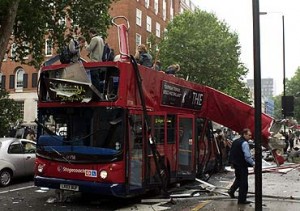7/7 2005: Forensic Investigations Find Military Grade Explosives at All Four Sites; Official Narrative Mysteriously Changes to ‘Homemade’ Explosives
Editor’s note.
In the immediate aftermath of the 7th July 2005 bombings, forensic investigations found traces of military grade high explosives at all four bomb sites. This was widely reported in the media (see sources below). As time went on, the UK government’s (and its mouthpiece, the BBC’s) official narrative changed to ‘homemade explosives’. Reports of high explosives being used are now very difficult to find, and have never been mentioned again.
Forensic investigations are a scientific process. The presence of military grade high explosives was confirmed by Christophe Chaboud, head of the French Anti-Terrorism Co-ordination Unit, as well as Scotland Yard’s Deputy Assistant Commissioner Brian Paddick. This important part of the official narrative subsequently changed, and reports of it were largely excised from the media, not to be uttered again. The British government is lying.
- Traces of military plastic explosive found in the wrecked Underground carriages and the bus: http://www.irishexaminer.com/archives/2005/0714/ireland/explosives-used-in-london-bombings-originated-in-the-balkans-664838892.html
- “All we are saying is that it is high explosives”: Scotland Yard Deputy Assistant Commissioner Brian Paddick: http://www.worldtribune.com/worldtribune/05/front2453563.0402777777.html
- Military-grade RDX explosives found at bomb sites: http://www.mirror.co.uk/tm_objectid=15713744&method=full&siteid=115875-name_page.html
Senior French Detective: 7/7 Explosives ‘of military origin’
By Jason Bennetto, Crime Correspondent, Tuesday, 12 July 2005.
The bombs used in Thursday’s terrorist attacks were of “military origin”, according to a senior French policeman sent to London to help in what has become the biggest criminal investigation in British history.
Christophe Chaboud, head of the French Anti-Terrorism Co-ordination Unit, told Le Monde newspaper that the explosives used in the bombings were of “military origin”, which he described as “very worrying”. ” We’re more used to cells making home-made explosives with chemicals,” he said. “How did they get them? Either by trafficking, for example, in the Balkans, or they had someone on the inside who enabled them to get out of the military establishment.”
He added that the victims’ wounds suggested that the explosives, which were “not heavy but powerful”, had been placed on the ground, perhaps underneath seats.
Up to 400 extra police are being drafted in to help with the bombing inquiry. Many of the additional officers will be helping with analysis of thousands of hours of video recordings from cameras on and around the Tube lines and bus struck by the terrorists. Police have so far taken 2,500 videotapes and are expected to examine many more during the inquiry.
Senior detectives said that the analysis of images from surveillance cameras was the biggest CCTV trawl ever. Scotland Yard was renting extra video suites to view the tapes. Detectives are hoping that among the tens of thousands of hours of footage will be pictures of the terrorists.
As well as examining cameras on the three Tube trains hit in the blasts, police have been recovering every camera in the stations that the trains travelled through, and cameras outside the entrance of every station. The Tube bombs were on the southbound Piccadilly line and the Circle line, which means that there were 40 Underground stations where the bombers could have got on board.
As well as examining cameras on shops, banks, and other businesses, the police will also look at speed cameras. The camera on board the No 30 bus that was blown up in Tavistock Square is thought to have been faulty.
A police source said of the CCTV task: “It is a massive job that is very time-consuming; it sounds impossible – but it’s not.” Between 200 and 400 extra officers from the Metropolitan Police are being deployed on the investigation. This comes on top of the 400 officers in the anti-terrorist branch and many of the 800 in the Met’s Special Branch.
The important role that CCTV can play in a criminal investigation was highlighted in the case of David Copeland, the “nail bomber” who staged attacks in Soho, Brixton and Brick Lane, east London. A team of police officers had 26,000 hours of surveillance footage from the dozens of cameras in Brixton, south London. They spent 24 hours a day scrutinising busy street scenes in their effort to spot the attacker.
The first sighting of the bomber was made from cameras filming the doorway of an Iceland food store. Copeland was identified by his boss and a cab driver after police released an image taken on the day he planted his first bomb in April 1999.
Forensic science specialists and anti-terrorist officers were continuing yesterday to examine the four crime scenes for traces of the bomb and a possible suicide bomber. This includes X-raying bodies to see if any bomb parts or timing devices, which could be vital clues, are embedded in them. It remains unclear if a terrorist died in the bus bomb, which went off an hour after the Tube explosions.
Detectives are checking all the victims from the bomb scene. An anti-terrorist source said they had recovered useful pieces of evidence, but were keeping an open mind as to whether a suicide bomber had been involved. Sir Ian Blair, commissioner of the Met, described the areas of investigation as “the biggest crime scenes in English history”.
James Hart, commissioner of the City of London Police, added: “We can’t possibly assume that what happened on Thursday was the last of these events …We have to be vigilant.”










thanks for all your great work bro..god bless
Leave your response!